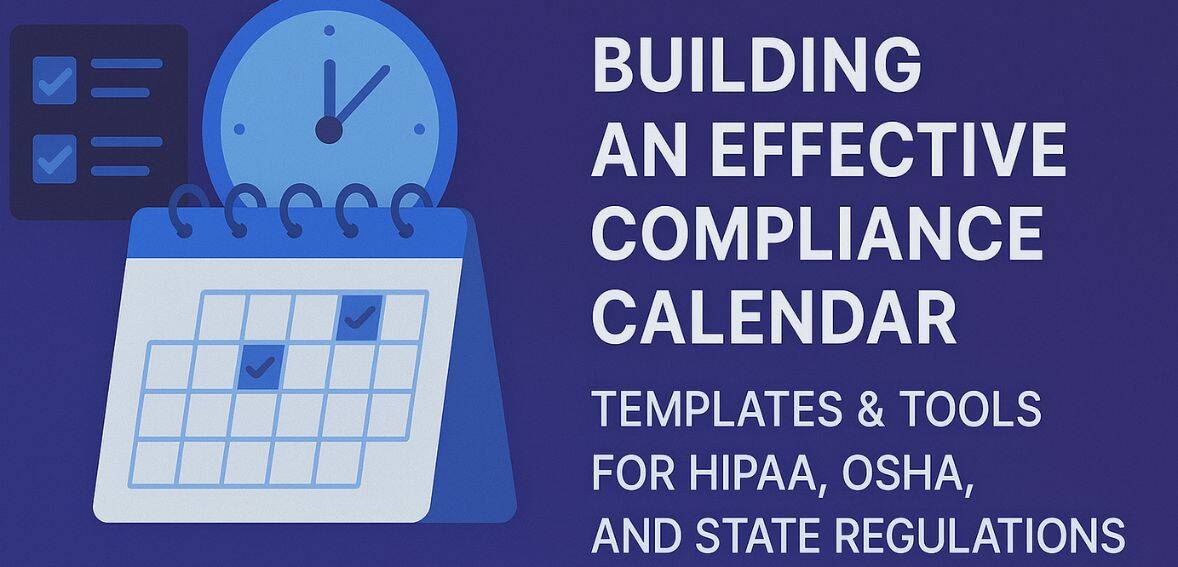
Building an Effective Compliance Calendar: Templates & Tools for HIPAA, OSHA, and State Regulations
Maintaining compliance with federal and state mandates, particularly HIPAA, OSHA, and various industry-specific laws, can be daunting in today’s highly regulated environment. Managing several deadlines, documentation requirements, audits, and training schedules becomes a daily struggle for small and mid-sized businesses. The answer is a thorough compliance calendar, which turns compliance from a last-minute scramble into a planned strategy.
Your team moves from crisis management to strategic oversight by keeping track of requirements, allocating responsibilities, and setting up automated reminders. By staying ahead of the game and making compliance ingrained in your company’s culture, you avoid responding to missed deadlines. This change promotes employee accountability, streamlines audits, reduces legal risk, and eventually improves your organization’s ability to handle change.
Understanding the Regulatory Universe: HIPAA, OSHA, and State Obligations

The scope of compliance obligations must be thoroughly understood by your team before creating an efficient calendar. HIPAA mandates recurring staff training, business associate management, breach notification protocols, yearly risk assessments, and periodic security reviews. Yearly hazard assessments, emergency response plan updates, incident log postings, first-aid/CPR recertification, industry-specific compliance for bloodborne pathogens, hearing conservation, etc. are all mandated by OSHA.
These are layered on top of state-level regulations, each with its own schedules and formats, whether they relate to environmental reporting, professional license renewals, nutrition labeling, or workplace posters. The end effect is a crammed compliance calendar that necessitates ownership, documentation, clarity, and accuracy. The first step in making complexity visible is proper mapping, which should be done by frequency, regulatory body, and responsible parties.
Structuring the Calendar: Frequency, Ownership, and Workflow Clarity

Frameworks that offer fine-grained accountability are essential to a strong compliance calendar. Monthly, quarterly, semi-annual, and annual statutory obligations must be arranged according to their frequency and synchronized with your company’s calendar. The requirement, regulatory source, accountable party (such as the HR lead, safety coordinator, or privacy officer), documentation format, and workflow steps should all be clearly stated in each entry.
Reminders for due dates should be planned months in advance, with follow-up and intermediate alerts sent out 30, 60, and 90 days beforehand. Pre-work (such as planning audits or data collection), execution, validation (sign-off and storage), and retention tracking (such as keeping injury logs for five years) are among the duties.
By automating these processes, whether through compliance platforms or shared spreadsheets, nothing is missed. Quarterly reviews held at leadership meetings strengthen executive visibility and promote departmental accountability.
HIPAA Requirements: Risk Assessment, Training, and Documentation
The cycle of yearly risk analysis, employee training, and continuous monitoring is the foundation of HIPAA compliance. Technical, administrative, and physical safeguards must be evaluated in risk assessments; vulnerabilities, remediation strategies, and residual risk should be recorded in checklist reviews. Attendee logs and test summaries are required for training sessions that cover privacy, HIPAA regulations, phishing awareness, and breach-reporting procedures.
Quarterly evaluations make sure policies are still applicable by monitoring modifications to software or authorized access. Calendars for business associate reviews must keep track of compliance evaluations and contract renewals. Response and communication should be tested in semi-annual tabletop breach scenarios. By scheduling these tasks into your calendar, you can ensure that compliance becomes routine rather than rare.
OSHA Responsibilities: Safety, Preparedness, and Training Audits

A thorough understanding of your workplace is necessary when creating an OSHA calendar. OSHA 300 logs and summary postings must be submitted annually for general industry. Reminders need to be planned because training certificates for first aid, CPR, and exposure to bloodborne pathogens expire every year. Each year or every two years, emergency action plans, PPE reviews, and hazard communications are conducted.
Depending on your workplace, at least semi-annual monitoring may be necessary for confined-space procedures, respirator programs, lockout/tagout policies, hearing conservation, and eye wash station certification. Compliance arcs can also be formed by critical incident investigations and follow-up schedules for medical surveillance. For ease of retrieval, every tracking line in your calendar needs to make clear the task owner, certification windows, training materials, and post-training documentation.
State Compliance and Professional Licensing: A Layered Approach

There are extra layers of licensing, required reporting, permits, leave accruals, and wage postings when operations cross state lines or take place in highly regulated industries like healthcare, the environment, or facility management. Workflows are specific to licensing expiration dates, renewal forms, CE hours, state-specific posting requirements, and environmental permits.
All state requirements by jurisdiction should be listed on your calendar, which owners must confirm and update every year. For ease of retrieval, documents need to be digitized and labeled with their effective and expiration dates. Plans need to be initiated and tracked, such as required vendor testing procedures or updates to pesticide permits. This guarantees that your compliance calendar accommodates both localized duty cycles and national standards.
Technology Frameworks: Using Tools, Walkthrough Templates

Although it is feasible, manually maintaining a compliance calendar is ineffective and prone to errors. Automation, centralization, and transparency are made possible by the use of digital systems, which range from spreadsheets with calendar reminders to official platforms like Comply365, Enablon, or Rectangle Health.
Columns for requirements, issuing body, deadline cadence, responsible party, documentation links, escalation steps, and notification timing are all essential components of a successful template. Workflow automation ensures reminders at 90, 60, and 30 days prior; ownership flags prompt oversight review, and dashboards show live compliance status.
For audit playback over retention periods, tools should also archive historical data. Integrations with shared drive repositories and email reminders are adequate for smaller teams; role-based platforms simplify visibility and control for larger operations.
Creating a Compliance-Winning Culture
A calendar is only useful when it is used. It is a cultural requirement to integrate compliance into day-to-day operations. Executives must present compliance as a shared duty; it is a reflection of organizational integrity and service quality rather than merely a way to avoid fines. Regular departmental and leadership meetings should cover calendar entries.
Document preparedness, audit preparation, and training completion should all be graded and monitored. Positive outcomes, such as flawless HIPAA reviews or OSHA inspections, ought to be made public. Checkbox compliance is transformed into pride through such reinforcement, especially when tied to patient-centered efforts like patient financing that reflect both compliance and care accessibility. Teams are more likely to remain accurate and proactive when they view compliance as an integral part of who they are.
Adapting to Change: Managing New and Unanticipated Obligations
Regulations are always changing, whether it’s state labor revisions, emergency health requirements, or OSHA clarifications. These updates need to be actively incorporated into your calendar. Set aside time once a month for regulatory review meetings, industry alerts, or government feed monitoring.
Calendar items need to be created, owners assigned, deadlines entered, and workflows started as soon as regulatory changes are discovered. This process is streamlined by tools with dynamic scheduling, which send alerts and initiate status updates. Without interfering with current processes, systems must be able to swiftly onboard new requirements.
Record Retention and Readiness for Audits
The physical compliance calendar is just half the context. Documentation is expected by regulatory agencies upon their arrival. Completion date data, responsible sign-offs, and documentation confirmation are all part of a comprehensive system. Calendar alerts that cause archival actions should be integrated with record retention policies, such as HIPAA privacy’s seven-year restriction or OSHA’s incident logs’ five-year restriction.
Tools with the ability to timestamp approvals, create audit-ready packets, and auto-export records are extremely valuable. The majority of regulators seek “proof, not promises,” so making sure that clean, sequential artifacts are easy to retrieve fosters trust and minimizes audit disruption.
Continuous Improvement: Making Your Compliance Calendar Flexible
A successful compliance calendar is dynamic and becomes increasingly intelligent over time. Effectiveness should be evaluated annually (following each compliance cycle): were alerts sent on time, tasks finished without slipping, and the calendar current? Processes should be redesigned, owner responsibilities should be made clear, or system triggers should be modified where errors occurred.
It is necessary to share the lessons learned from external audits. During update sessions, add any requirements that are missing based on self-reviews. Additionally, overlapping priorities, chances for consolidation, or bandwidth freeing should be noted in quarterly leadership feedback. Continual maturity guarantees that your system will not become outdated as regulations change.
Integrating Compliance Calendars with Broader Risk Management Strategy
Even though a compliance calendar is strong on its own, it works even better when combined with a larger enterprise risk management (ERM) framework. Risk encompasses more than just missed deadlines; it also includes operational delays, regulatory fines, reputational damage, and even insurance issues. You can develop a more comprehensive understanding of organizational exposure by coordinating your compliance calendar with internal risk registers.
For example, leadership can more strategically assign safety audits or staff training if high-injury departments are linked to recurrent OSHA violations. Deeper changes to IT policies may result from HIPAA gaps found during calendar reviews that are directly related to cybersecurity risk ratings. In the same way, delays in license renewal may lead to cross-functional reviews that include compliance, legal, and HR.
The calendar turns into a functional, visual dashboard that shows new vulnerabilities across departments in addition to legal deadlines. Including risk committees or quarterly ERM reports in your calendar improves accountability and decision-making. Instead of responding to an incident after it has happened, it enables leadership to direct resources where preventive measures have the greatest impact.
With this multi-layered approach, your compliance process becomes a proactive safeguard that improves organizational resilience beyond simple compliance. Beyond simply keeping track of tasks, a smart compliance calendar facilitates risk anticipation and mitigation on all fronts.
Conclusion: Compliance Planning as a Strategic Asset
A well-designed compliance calendar is a fundamental tool for robust, compliant organizations, not just a logistical one. You can transform complexity into an operational advantage by mapping regulatory obligations, clearly defining ownership, automating alerts, establishing a compliance culture, and gradually improving systems.
Execution is aided by tools and templates, but when compliance becomes second nature, the true transformation takes place. Keeping a living calendar helps you stay ahead of changes, encourage accountability, and lower risk as your company develops. Compliance planning transforms from a tedious task into a strategic advantage that promotes long-term organizational integrity, employee welfare, and patient safety.